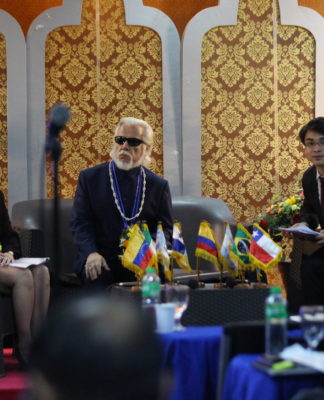QUESTIONING Catholic doctrines and religious practices is a sign that people want more understanding of their faith, according to a high-ranking priest.
Msgr. Sabino Vengco Jr. of the Diocese of Malolos answers common questions on faith and religious practices in a new book titled “Itanong Kay Monsi.”
“[The book] reminds us that the Church’s mission to proclaim and teach the faith is for the believers,” Vengco says in the foreword.
The book, which sheds light on 155 questions, discusses Jesus, the apostles and the saints, Mary’s role as “co-redeemer” and intercessor, the relationship between the Church and politics, and how the Church deals with science.
Question 22 asks: “Why is the Church opposed to the Reproductive Health bill?” Vengco says it’s because it would, in effect, legalize abortion.
“Reproductive health care is understood by the bill to include availability and access to ‘management of post-abortion complications’ and correspondingly enables the Commission on Population to fully implement the services for the management of post-abortion complications, thereby in effect decriminalizing and legitimizing abortion.”
The first question asks if abortion remains wrong when the purpose is to save a life.
Vengco defines abortion as “a malicious and direct assault on human life within the womb and it can never be permissible. In the case mentioned, to directly abort the baby would be murder.”
Even with the principle of “double effect,” Catholic morality rarely allows a fetus’ unintended abortion.
The principle of double effect has four limiting norms: the action is good; the good effect is not obtained by means of evil effect; there is sufficient reason for permitting the unsought evil effect that unavoidably follows; and the evil effect is not intended in itself but is merely allowed to happen as a consequence of the good effect.
On page 139, the book discusses the Catholic Church’s stand on divorce. It distinguishes legal separation, which legitimizes only the physical separation of the spouses but maintains the marital bond, and divorce, which dissolves the bond itself.
“The Catholic Church rejects divorce as it means the dissolution of an existing and valid marriage, and the ensuing freedom of the spouses to remarry,” Vengco says. “[The] Church’s opposition to divorce is in faithfulness to the clear teaching of Jesus Christ that in the Creator’s design, the union between a husband and a wife is binding for life.”
Question 71 underscores the importance of the ministry for homosexuals, which poses “a real pastoral problem for the Church,” Vengco says.
“Persons with homosexual inclination or same-sex attraction do not have it easy, and they deserve our respect, compassion, and sensitivity,” Vengco says. “There is no justification to any discrimination against them. Homosexual persons are called to chastity. They also have the duty to control their tendency by the necessary means within their power.”
The book reiterates that marriage between two men or two women is not accepted by the Church. “Marriage in the light of our Christian faith is a sacrament of divine grace. It is different from the kind of marriage, which has a mere sociological understanding and can be interpreted as a matter of human convention only.”
The 474-page book also tackles issues like charter change, the clergy and sex scandals, ecumenism and interreligious dialogue, witchcraft, Viagra, the lotto, cloning, cosmetic surgery, disasters, environment, cheating in school, and the end of the world.
More on faith
Question 96 asks about the origin of Marian devotion. Vengco says the people’s experience of God and of his providence includes “the special help and protection of the Blessed Virgin Mary. From these arise popular devotions, novenas, pilgrimages, and fiestas.”
The practice of dressing up the image of the Sto. Niño in different attires like that of a fireman, a vagabond, and a school pupil is discussed in Question 127.
“The practice is not exclusive to us, Filipinos, though with us it is carried out with almost reckless abandon. It is not necessarily disrespectful to dress the child Jesus, but can be an endearing act of identification whereby the devout prayer is implicit that the Child Jesus be the companion and powerful protector of the type so represented,” Vengco says.
Discussing the apocalypse, Question 50 asks: “As we approach the turn of the millennium, there is much talk about the end of the world. Are there really prophecies pointing to this fearsome event?”
“We do not bother ourselves with this type of negative, terrorizing eschatology. For us, the end and the last things are our fulfillment in the saving love of the Triune God,” Vengco says.















